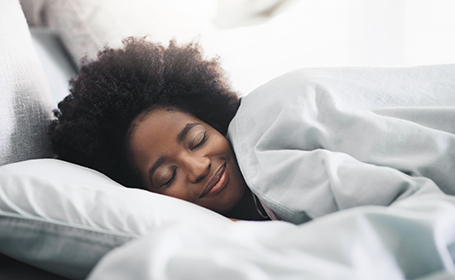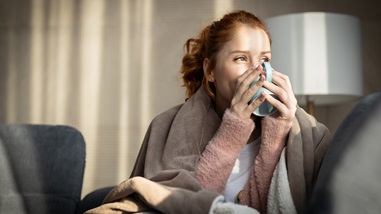
Painsomnia: techniques for falling asleep with chronic pain
Painsomnia describes a vicious cycle of sleep problems that both exacerbate and are exacerbated by chronic pain. We explore the concept and consider ways to tackle the issue
We shine a spotlight on the condition and talk more about methods for coping with painsomnia.
Everything you need to know about painsomnia
 Studies shared by The National Library of Medicine show that about 50-70% of people with rheumatoid arthritis suffer from disturbed sleep as a result of chronic pain. The term ‘painsomnia’ was coined by members of the rheumatoid arthritis community and was originally used by members of online support forums to describe insomnia (or poor sleeping habits) resulting from chronic pain.
Studies shared by The National Library of Medicine show that about 50-70% of people with rheumatoid arthritis suffer from disturbed sleep as a result of chronic pain. The term ‘painsomnia’ was coined by members of the rheumatoid arthritis community and was originally used by members of online support forums to describe insomnia (or poor sleeping habits) resulting from chronic pain.
Painsomnia is now used regularly to define the vicious cycle of chronic pain and disturbed sleep experienced by people with pain stemming from a variety of sources. Circle Health Group’s Joint Pain Matters survey found that 38.6% of respondents suffered from poor sleep every night as a result of joint pain.
What is rheumatoid arthritis?
Rheumatoid arthritis is an autoimmune disease. It happens when your body's immune system attacks and destroys your affected joint, causing pain and swelling. It can lead to reduced movement and the breakdown of bone and cartilage across your joint, which causes difficult symptoms including pain, swelling, and stiffness.
Restorative sleep... is important for brain function... and also helps regulate your emotions.
Why is sleep so important?
According to a 2008 EPIFUND study, restorative sleep — which comprises the completion of all five stages of sleep — is important for brain function. It releases growth hormones that repair the cells in your body, allowing you to heal and grow. Restorative sleep also helps regulate your emotions.
Studies show that sleep disorders affect nearly half of people reporting chronic pain, with a quarter suffering from clinical insomnia.
People with painsomnia are less likely to experience restorative sleep. This can lead to mental health issues such as depression and anxiety. It can also cause poor memory and concentration.
Conditions such as rheumatoid arthritis and fibromyalgia, which cause joint pain and stiffness, often result in painsomnia.
While it is important to speak to your consultant about painsomnia, there are methods you can implement yourself to achieve a better night’s sleep.
Exercise during the day helps you sleep at night
Studies have explored the relationship between exercise and insomnia, identifying exercise as a potential solution to achieving restorative sleep.
As Johns Hopkins Medicine explains, we don’t fully understand why exercise improves sleep issues. But there is ample evidence to show that it does. One possibility of this is the effect that exercise has on your internal body clock, known as your circadian rhythm.
Your internal body clock is a natural system in your body that controls when you need to eat, sleep and wake up. Exercise at certain hours throughout the day can help reset your body clock and regulate the time you fall asleep and wake up.
We understand that listening to your body clock is challenging when in pain. However, according to The National Library of Medicine, exercise during the day could naturally improve your circadian rhythms, helping you establish a more settled routine.
Harvard Medical School research shows that exercise also releases chemicals called endorphins. These chemicals reduce feelings of stress, anxiety and depression. According to Harvard, if you feel less anxious, your muscles are more likely to relax and your mind is more likely to feel clear.
While exercise might be the last thing on your mind if you suffer from joint pain, it could result in joint pain relief and a better night’s sleep. And you do not need to partake in strenuous exercise to experience joint pain relief. Any form of movement, however low-impact, will loosen your joints and strengthen and condition your muscles, and could result in short and long-term pain relief.
Activities such as swimming, stretching, and short-distance cycling are often recommended to improve joint pain. Upping your exercise in this way could improve your sleep cycle, and help you manage your joint pain.

CBT for painsomnia
CBT (cognitive behavioural therapy) is often used to treat sleep issues.
CBT is a form of talking therapy that can reshape your thinking patterns and behaviours. CBT for sleep issues involves a structured programme, helping you address thoughts and actions that could negatively affect your sleeping habits. Some features of this programme could include:
Relaxation techniques
These help you to relax your mind and body through meditation, muscle relaxation, mental refocusing and mindfulness.
Improving sleep hygiene
This method involves changing lifestyle habits that influence sleep. Habits that can hinder good sleep include include drinking stimulants (alcohol and coffee), smoking and not getting enough exercise. Sleep hygiene also refers to the nature of your bedtime routine, bedding and sleeping environment (your bedroom).
Biofeedback
This technique teaches you to observe and adjust biological responses at night-time, such as your heart rate and muscle tension. Your sleep specialist may ask you to use a wearable biofeedback device for this part of the programme. This device will identify your biological responses.
CBT for sleep issues also uses mindfulness-based therapy to help you feel calmer and manage disruptive thought patterns.
Many of our Consultants and therapists at Circle Health are trained in CBT. If you think CBT might be right for you, one of our specialists can help.
One of the most effective forms of meditation for people with joint pain is mindfulness meditation.
Practice meditation before bed to manage painsomnia
Meditation is a practice used to centre your thoughts. It is not about becoming a new and improved person. It is simply about achieving a clear mind.
One of the most effective forms of meditation for people with joint pain is mindfulness meditation. This practice involves focusing on the present, deep breathing , and refocusing negative thinking patterns.
Mindfulness meditation might help you fall asleep more easily when in pain. This is because it relaxes the muscles, which can ease joint pain and stiffness. It also helps you to focus intently on a thought or feeling outside of your pain.
Mastering mindfulness meditation can be difficult at first, but there are many resources available to help you.
Distractions often go a long way
Sometimes, distractions can help you drift off slowly.
Whether this be in the form of your favourite book, TV show, or podcast, occupying your mind with something until you fall asleep might be a solution for you.
Listening to mindfulness podcasts often work as a distraction. These often include relaxing music, ASMR, breathing tutorials and tips for clearing your mind. These features might distract you from your pain and help you achieve a refreshing night’s sleep.
Book an appointment with us
If you’re suffering from joint pain, we have many joint pain specialists, also known as orthopaedic consultants, who can help. We also have psychiatrists and sleep specialists to help you tackle painsomnia.
To speak with one of our Circle Health Group consultants, you can book an appointment online or give us a call today.
Tags
How do I book an appointment?
If you're concerned about symptoms you're experiencing or require further information on this subject, talk to a GP or see an expert consultant at your local Circle Hospital.